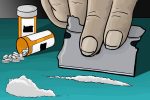Barbara Harris, the director and founder of Project Prevention, has one goal: paying drug-addicted people to not conceive children. In order to do so, her program employs two methods, either long-term birth control or sterilization. The foundation explains that it will pay cash for “long term or permanent birth control.”
Project Prevention also notes that in doing so, not only will children be spared from the wrath of individuals suffering from addiction, but both social workers and society at large will benefit from a reduction in crime rates and a lessened strain on public resources. While the foundation touts the numerous positive benefits of the program, the fundamental ethical question remains: Is it okay to sterilize drug addicts?
The founder of Project Prevention was driven to start the program after witnessing firsthand the hardships of children born to drug-addicted parents; Harris adopted four children who struggled through withdrawal because of their birth mother’s choices. As explained on the foundation’s website, such a struggle motivated Harris to pitch a bill to California legislatures that made it mandatory that, after giving birth to a drug-addicted baby, the birth mother would use long-term birth control.
The bill gained very little traction and Harris was left with an alternative route: creating Project Prevention. While not all aspects of the program are negative, there are a few important facets that need to be addressed that question not only the foundation’s moral fiber, but also a larger societal view of drug addicts and how they should be treated.
Less-Than-Reasonable Solutions
Offering sterilization for monetary gain to drug addicts is cause for concern because it can be argued that drug addicts aren’t in the right frame of mind to make a permanent decision that will affect their lives in the future.
It’s no secret that addiction is a beast and offering money to someone suffering from drug addiction seems like a manipulative move. Addiction tends to make users short-sighted; their only concern for the time being is where they’re getting their next fix, not whether or not they want to start a family in years to come.
The premise of sterilization also begs the question of whether or not Project Prevention believes that addicts can become and remain sober. If Harris and her cohort believed in the ability of users to rehabilitate, they would be substantially less likely to encourage an irreversible procedure, such as sterilization.
However, instead of focusing on the cynical, dystopian nature of the organization’s mission, Project Prevention trumpets the perceived benefits of their program, i.e. an alleviation of crime and reduced strain on social workers.
However, the organization declines to provide statistical evidence — however difficult that would be to obtain, given the number of involved variables — about the success rate of their methodology. Anecdotally, at least, one might be forgiven for being skeptical. Believing that sterilizing drug users reduces crime rates feels less like a guarantee and more like a hopeful projection. As for social workers, fewer cases of children in foster care could be a potential outcome, but sterilization shouldn’t be proposed as the best way to get there.
Another problem with performing sterilization on drug-addicted people sends the message that drug addiction is a permanent condition. When someone is in the pits of addiction, the future can, at best, seem bleak, and at worst, nonexistent.
Although, when sobriety is reached, there are countless stories from former drug addicts who explain that they never thought they would be where they are today. Be it as a teacher or a lawyer, the possibilities for those who escape the vise-like grip of drug addiction are endless. The same holds true with becoming a parent, but that option is taken away from those who made a decision to agree to sterilization while in the throes of addiction.
However, the Project Prevention website offers a list of haunting statistics, one of which is hard to ignore when contemplating the merits of their proposal. According to the foundation, more than half — 55 percent — of the 16,000 children in foster care in California, as of Sept. 3, 2015, were taken from their homes because of parental drug use.
The overlap between parents with drug issues and children in foster care is unsettling, and it’s abundantly clear that something needs to be done to combat such a prevalent problem. I can’t say, though, with a clear moral conscience, that sterilizing drug addicts is the correct path to such a solution.
Not All Bad
I’m not aiming to demonize Project Prevention because I think that some of their objectives are a step in the right direction, such as offering “long-term” birth control as an option rather relying solely on sterilization. An article published by The Los Angeles Times described the birth control methods offered by the foundation are “IUDS, implants, hormone patches and shots.”
Accessibility to birth control is a great thing for women addicted to drugs because it makes them gatekeepers of their own sexual health and wellbeing. I do wonder how Project Prevention ensures that the women who are prescribed certain forms of birth control, such as injections, are taking them on a regular basis.
The foundation’s website also explains that sterilization and long-term birth control aren’t the only thing they offer to those in need; they also refer women to other drug treatment programs to combat addiction.
Project Prevention’s website also describes how Harris continually reaches out to those who worked with the foundation to bolster support through either treatment or relapse. Such an effort is not only commendable but also crucial because giving addicts a support system to fall back on during either aforementioned situation plays a big role in whether or not they can get through treatment successfully.
Drug addiction in the United States, especially opioids, have reached a critical number and it’s necessary for foundations like Project Prevention to work in lockstep with other organizations to provide support for addicts. While some components of the program might ruffle some feathers, the program’s redeeming elements make it an option that some addicts might find success in.

















